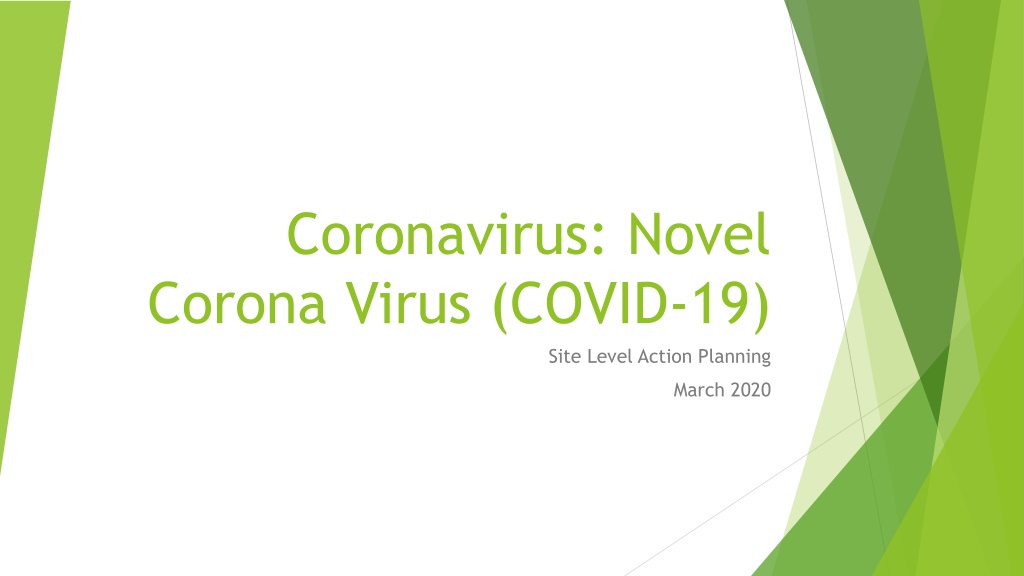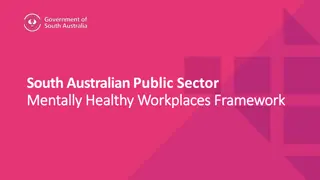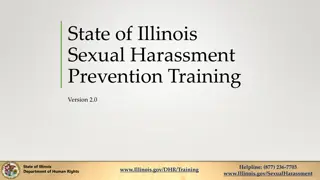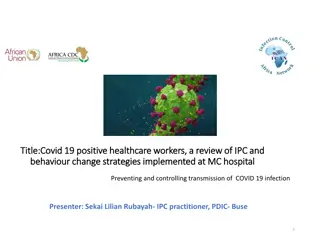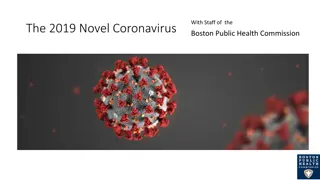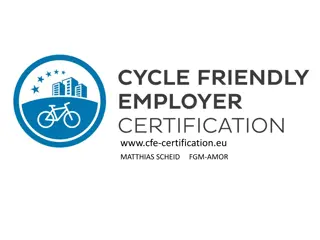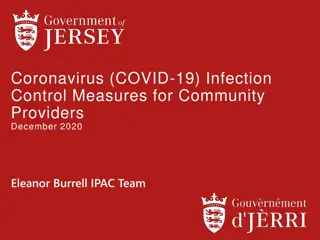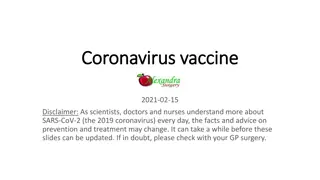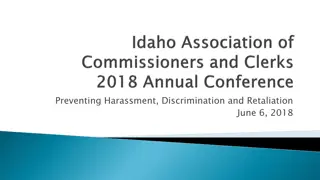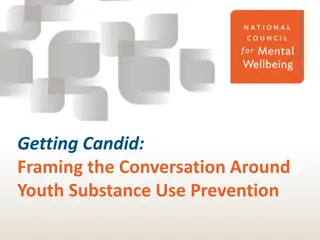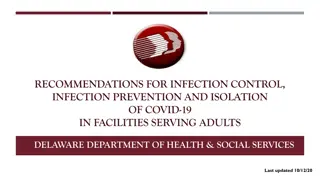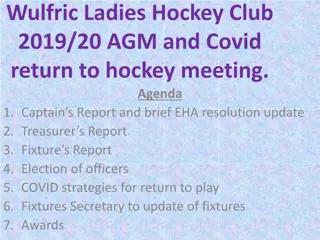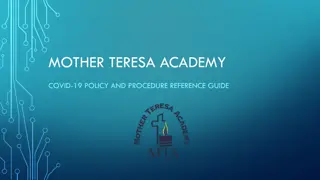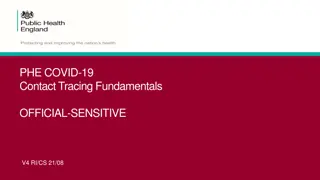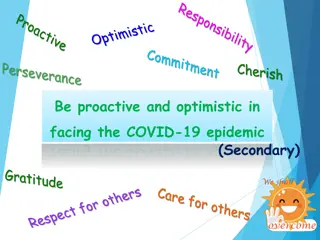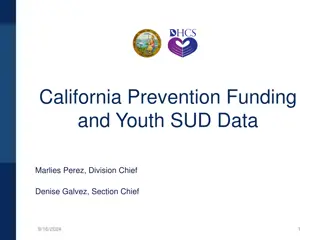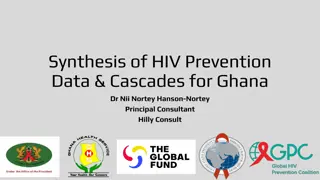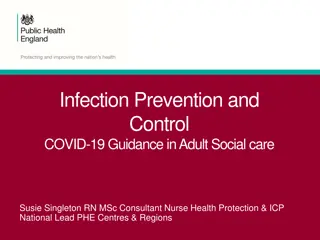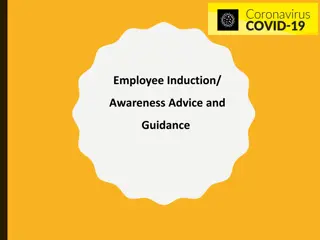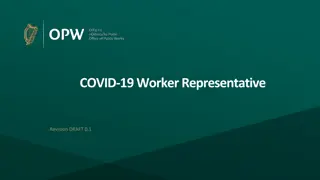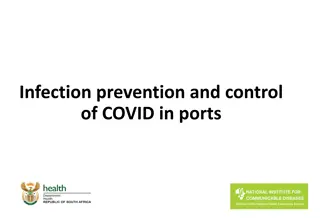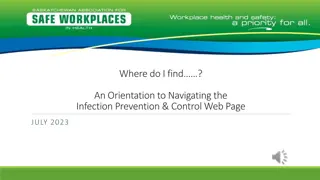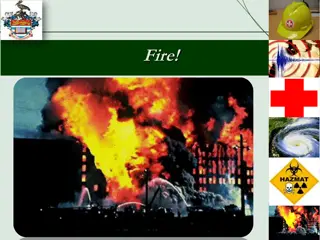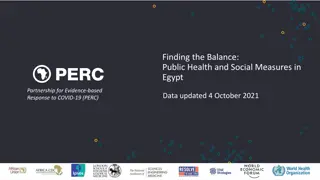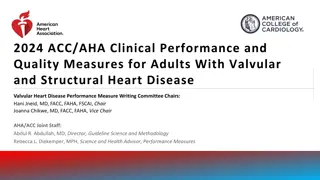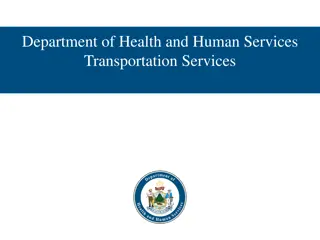COVID-19 Prevention Measures in Workplaces
Establishing a local task force, communicating prevention practices, addressing sick personnel guidelines, enhancing cleaning protocols, and implementing social distancing are crucial steps to prevent the spread of COVID-19 in workplace settings. Clear communication, hygiene practices, travel restrictions, and meeting protocols play key roles in ensuring a safe environment for employees.
Download Presentation

Please find below an Image/Link to download the presentation.
The content on the website is provided AS IS for your information and personal use only. It may not be sold, licensed, or shared on other websites without obtaining consent from the author. Download presentation by click this link. If you encounter any issues during the download, it is possible that the publisher has removed the file from their server.
E N D
Presentation Transcript
Coronavirus: Novel Corona Virus (COVID-19) Site Level Action Planning March 2020
Steps to help prevent the spread of COVID-19 1. Establish site level local task force: Director of Operations/EHS and HR Staff a. For central point of commination; strategy, etc. 2. Communicate to all site personnel COVID-19 prevention best practices. Consistent Reminders. a. Via plant postings, email blasts and small group meetings. Keep the team informed. 3. What to do if sick? Provide guidance to site personnel on steps to take if sick. 4. How to handle employees who may be ill (location to isolate/medical department). 5. Identification and protection of At Risk personnel. Communicate heightened awareness and PPE guidance for Healthcare workers as well as those routinely deal with the public (shipping/receiving and security personnel, etc.) 6. Establish enhanced Cleaning Protocols for high touch/high exposure areas 7. Manage needed cleaning supplies, protective materials and PPE (disinfectants; cleaning supplies; hand sanitizer; masks/latex gloves, etc.)---ensure adequate supplies 8. Implement Meeting Etiquette---No large face to face meetings (10 people max) 9. Upgrade Visitor Control protocol (Identify critical visitors and communicate to non-critical visitors the need to eliminate all non-essential visits) 10.Implement Social Distancing - Cafeteria/Locker Rooms avoid grouping and manage locker room accessibility
1. Establish site level local task force COVID 19 Task Force The Director of Operations or site leader, along with HR/EHS and operations leadership shall develop team to execute strategy as it relates to the implementation of COVID-19 systems. This team shall establish a cadence of regular meetings (at least once per day) to address concerns relate to COVID-19 task management. For central point of commination; strategy, etc. Need a consistent, unified message. Progress shall be tracked and documented.
2. Communicate to all site personnel COVID-19 Prevention best practices Practice good hygiene Stop handshaking use other noncontact methods of greeting (smiles, waves, be creative) Clean hands at the door and schedule regular hand washing reminders by email Create habits and reminders to avoid touching their faces and cover coughs and sneezes Disinfect surfaces like doorknobs, tables, desks, and handrails regularly increase frequency Increase ventilation by opening windows if feasible Be careful with meetings and travel Business air travel and business conferences are prohibited until further notice Employees who travel to a high-risk area as identified by the United States Center for Disease Control (CDC) for personal reasons (e.g., vacation) are to notify their Human Resources Department and will be advised on protocol for returning to work Meetings at our facilities with more than 10 people are prohibited Use videoconferencing/WebEx/Go To Meeting or similar program for meetings when possible If in-person meetings are required, meetings are to be held in well-ventilated spaces and participants should practice social distancing by staying at least 2 meters (6 feet) apart
2. Communicate to all site personnel COVID-19 Prevention best practices Handle food carefully Eliminate food sharing Ensure cafeteria staff and their close contacts practice strict hygiene Stay home if They are feeling sick They have a sick family member in their home Repeatedly, creatively, and thoroughly encourage employees and others to take the following steps. Wash your hands often with soap and warm water for at least 20 seconds. If soap and water are not available, use an alcohol-based hand sanitizer. Avoid touching your eyes, nose, and mouth with unwashed hands Avoid close contact with others, especially those who are sick Refrain from shaking hands with others for the time being Cover your cough or sneeze with a tissue, then throw the tissue in the trash Clean and disinfect frequently touched objects and surfaces Perhaps the most important message you can give to employees: stay home when you are sick The best way to prevent infection is to avoid exposure
2. Communicate to all site personnel COVID-19 Prevention best practices Repeatedly, creatively, and thoroughly encourage employees and others to take the following steps. As an employer, we should be doing the following: Ensure that employees have ample facilities to wash their hands, including warm water and soap, and that third-party cleaning/custodial schedules are accelerated. Evaluate your remote work capacities and policies. WebEx/Teleconference or use other remote work tools in lieu of meeting in person. Consider staggering employee starting and departing times, along with lunch and break periods, to minimize overcrowding in common areas such as elevators, break rooms, etc. Consider staggering production times and schedules to minimize employee interaction. Review if this is feasible/possible. Have a single point of contact for employees for all concerns that arise relating to health and safety. Follow updates from the CDC and the World Health Organization (WHO) regarding additional precautions. Keep postings, poster and new development in front of people. The best way to prevent infection is to avoid exposure
3. What to do if sick? What to do if an employee appears sick? If any employee presents themselves at work with a fever or difficulty in breathing, this indicates that they should seek medical evaluation. While these symptoms are not always associated with influenza and the likelihood of an employee having the COVID-19 coronavirus is extremely low, it pays to err on the side of caution. Communicate to your supervisors on the importance of not overreacting to situations in the workplace potentially related to COVID-19 in order to prevent panic among the workforce.
3. What to do if sick? Guidance: Stay home except to get medical care You should restrict activities outside your home, except for getting medical care. Do not go to work, school, or public areas. Do not use public transportation, ride-sharing, or taxis. Seek medical advice Call ahead before visiting your doctor and tell them that you may have COVID-19 infection. This will help the healthcare provider take steps to keep other people from getting infected or exposed. Telemedicine services (e.g., MDLive) are also an option for medical advice. Separate yourself from other people in your home As much as possible, you should stay in a specific room and away from other people in your home. Also, you should use a separate bathroom, if available. Clean your hands Wash your hands often with soap and water for at least 20 seconds. If soap and water are not available, clean your hands with an alcohol-based hand sanitizer that contains at least 60% alcohol, covering all surfaces of your hands and rubbing them together until they feel dry. Soap and water should be used preferentially if hands are visibly dirty. Avoid touching your eyes, nose, and mouth with unwashed hands.
3. What to do if sick? Guidance: Avoid sharing personal household items You should not share dishes, drinking glasses, cups, eating utensils, towels, or bedding with other people in your home. After using these items, you should wash them thoroughly with soap and water. Cover your coughs and sneezes Cover your mouth and nose with a tissue when you cough or sneeze. Throw used tissues in a lined trash can and wash your hands with soap and water for at least 20 seconds. Wear a facemask You should wear a facemask when you are around other people (e.g., sharing a room or vehicle) and before you enter a healthcare provider s office. If you are not able to wear a facemask (for example, because it causes trouble breathing), then people who live with you should not stay in the same room with you, or they should wear a facemask if they enter your room.
4. Establish area to isolate employees who may be Ill Medical department Separate sick employees The CDC recommends that employees who appear to have acute respiratory illness symptoms (i.e. cough, shortness of breath) upon arrival to work or become sick during the day should be separated from other employees and be sent home immediately. Sick employees should cover their noses and mouths with a tissue when coughing or sneezing (or an elbow or shoulder if no tissue is available). Medical professionals shall use Standard Precautions, Contact Precautions, and Airborne Precautions and eye protection when caring for patients with confirmed or possible COVID-19.
5. Identification and protection of At Risk personnel Communicate heightened awareness and guidance for affected personnel Healthcare Personnel Healthcare personnel caring for patients with possible COVID-19 should adhere to CDC recommendations for infection control and prevention (ICP): Assess patients with acute respiratory symptoms and risk factors for COVID-19 to minimize chances of exposure, including placing a facemask on the patient and isolating them; Use Standard Precautions, Contact Precautions, and Airborne Precautions and eye protection when caring for patients with confirmed or possible COVID-19; Perform hand hygiene with alcohol-based hand rub before and after all patient contact, contact with potentially infectious material, and before putting on and upon removal of PPE, including gloves. Use soap and water if hands are visibly soiled; Practice how to properly don, use, and doff personal protective equipment (PPE) in a manner to prevent self-contamination.
5. Identification and protection of At Risk personnel Communicate heightened awareness and guidance for affected personnel Shipping/receiving and security personnel, etc. Utilize social distancing Avoid direct physical contact, such as hand-shaking, hugs, etc. Wash hands frequently Provide latex gloves for use
6. Implement Enhanced Cleaning Protocols Routine Cleaning: Soiled and frequently touched surfaces can be reservoirs for pathogens, resulting in a continued transmission to people. Therefore, for pathogenic microorganisms that can transmit disease through indirect contact (transmission through contaminated surfaces), extra attention should be paid to surfaces that are touched most often by different individuals. As part of standard infection control practices in high traffic area settings, routine cleaning should be enhanced and done more frequently. Routine cleaning of high traffic areas include: Cleaning high contact surfaces that are touched by many different people, such as light switches, handrails and doorknobs/handles increase frequency Vacuuming of entryways and high traffic areas Removing trash Cleaning restrooms Wiping heat and air conditioner vents Spot cleaning walls Spot cleaning carpets In addition to our current cleaning schedule, it is now necessary to institute enhanced cleaning protocols to include more frequent cleaning of high touch point areas, to include: cafeterias, restroom/locker room areas, countertops, handrails and doorknobs.
6. Implement Enhanced Cleaning Protocols Cleaning and Disinfection: Cleaning removes germs, dirt and impurities from surfaces or objects, while disinfecting kills germs on surfaces or objects. Staff should perform cleaning and disinfection of frequently touched areas routinely. Step 1: Cleaning: Always clean surfaces prior to use of disinfectants in order to reduce soil and remove germs. Dirt and other materials on surfaces can reduce the effectiveness of disinfectants. For combination products that can both clean and disinfect, always follow the instructions on the specific product label to ensure effective use. Step 2: Disinfection: Cleaning of soiled areas must be completed prior to disinfection to ensure the effectiveness of the disinfectant product. Use a disinfectant labeled to be effective against viruses. If such products are unavailable, it is also acceptable to use a fresh 2% chlorine bleach solution (approximately 1 tablespoon of bleach in 1 quart of water). Prepare the bleach solution daily or as needed.
6. Implement Enhanced Cleaning Protocols Cleaning and Disinfection: Label directions must be followed when using disinfectants to ensure the target viruses are effectively killed. This includes adequate contact times (i.e., the amount of time a disinfectant should remain on surfaces to be effective), which may vary between five and ten minutes after application. Disinfectants that come in a wipe form will also list effective contact times on their label. For disinfectants that come in concentrated forms, it is important to carefully follow instructions for making the diluted concentration needed to effectively kill the target virus. This information can be found on the product label.
6. Implement Enhanced Cleaning Protocols Cleaning and Disinfection: Cleaning and disinfecting should be conducted by staff who have been trained to use products in a safe and effective manner. Staff should be reminded to ensure procedures for safe and effective use of all products are followed. Staff do not need to wear respiratory protection while cleaning. Safety instructions are listed on product labels and include the personal protective equipment (e.g., gloves) that should be used. Place all used gloves in a bag that can be tied closed before disposing of them with other waste. Wash hands with soap and water for at least 20 seconds immediately after removing gloves or use an alcohol- based hand sanitizer if soap and water are not available. Soap and water should be used if hands are visibly soiled.
7. Manage cleaning supplies, protective materials, & PPE Ensure adequate supplies Disinfectants; cleaning supplies and hand sanitizer We need to be mindful of the hysteria related to the COVID-19 virus and how this can impact our ability to obtain supplies needed to keep our employees safe. We are committed to conserving the supplies needed to maintaining employee safety. Our teams will continue to work to ensure adequate supplies are available. If an area is experiencing an issue or supply shortage, you should reach out to your normal site contact for guidance. We will continue to monitor inventory levels and will remain in direct communication with vendors to ensure adequate supply.
7. Manage cleaning supplies, protective materials, & PPE Ensure adequate supplies Who needs PPE: Healthcare personnel should adhere to Standard, Contact, and Airborne Precautions, including the use of eye protection (e.g., goggles or a face shield) when caring for potentially infected patients. These precautions include the use of PPE, including NIOSH-approved N95 respirators, gowns, gloves, face shield/eye protection, etc. This includes, but is not limited to, surgical N95 respirators. Janitorial staff should take extra precautions during this time. This includes mandatory use of gloves (if not being used already). Patients with confirmed or possible SARS-CoV-2 infection should wear a facemask when being evaluated medically. Who does not need PPE: CDC does NOT currently recommend the general public use facemasks. Instead, CDC recommends following everyday preventive actions, such as washing your hands, covering your cough, and staying home when you are sick.
7. Manage cleaning supplies, protective materials, & PPE Ensure adequate supplies Assess risk and use PPE appropriate for exposure Nitrile gloves Latex gloves Masks Filtering Facepiece Respirator's Goggles/Face shield Gowns *Ensure adequate supplies and maintain close contact with vendors related to available materials and inventories FAQ - PPE https://www.cdc.gov/coronavirus/2019-ncov/hcp/respirator-use-faq.html
8. Implement Meeting Etiquette Meeting Guidelines Meetings at company facilities with more than 10 people are prohibited. Use videoconferencing/WebEx/Go To Meeting or similar services for meetings when possible. If in-person meetings are required, meetings are to be held in well-ventilated spaces and participants should practice social distancing by staying at least 6 feet (2 meters) apart. Have sanitizer available in all meeting rooms.
9. Visitor Control protocol Identify essential visitors and communicate to non-essential visitors the need to eliminate all non- essential visits No nonessential visitors are permitted at all company locations until further notice. If the visitor performs services that must be done in our company s facilities or has business-critical meetings, they are required to complete the COVID-19 Visitor Questionnaire. To protect the health of everyone at our site(s), we will now require additional screening of all visitors prior to entry into our facilities. Effective immediately, all visitors entering our facilities are required to complete the COVID-19 Visitor Questionnaire. If any questions are answered yes, access will be denied and the visitor will be asked to reschedule their meeting or make other arrangements. This process will be administered at the site level using visitor management protocols. Site leadership shall determine those visitors who are essential to run their business and those that are non-essential and manage accordingly. This is a fluid situation, please proceed with caution when managing this process to ensure we are doing what is best for our employees and business.
10. Implement Social Distancing Protocols Guidance Maintain safe distance (If in-person meetings are required, participants should practice social distancing by staying at least 6 feet (2 meters) apart. Avoid activities that involve close interaction Avoid the crowded areas Avoid handshakes and hugs Avoid schools, movie theaters, sporting events, or other higher mixing areas Avoid necessary places like stores during peak hours Avoid rush hour and any situation that tends to attract many people Be careful with public pens and other such things Don t hold or attend large meetings or gatherings Potential Areas of Risk Cafeterias Luncheons Break Rooms/Areas Copier Rooms Mail Rooms Locker Rooms Town Hall Meetings Safety Meetings 6 feet *Avoid grouping and actively communicate these expectations
10. Implement Social Distancing Protocols What is Social Distancing and how is it achieved? Social distancing is a practice recommended by public health officials to stop or slow down the spread of contagious diseases. It requires the creation of physical space between individuals who may spread certain infectious diseases. The key is to minimize the number of gatherings as much as possible and to achieve space between individuals when events or activities cannot be modified, postponed, or canceled. Additionally, there is a particular focus on creating space between individuals who have come together on a one-time or rare basis and who have very different travel patterns such as those coming from multiple countries, states or counties. What will this achieve? The timely implementation of aggressive strategies that create social distance and those that reduce close contact of people not regularly together, including limiting gatherings, has proven effective in prior pandemics at delaying rates of transmission and reducing illness and death.
Action Plans Summarize in a Site Level Action Plan 1. Establish site level local task force: Director of Operations/EHS and HR Staff a. For central point of commination; strategy, etc. 2. Communicate to all site personnel COVID-19 prevention best practices. Consistent Reminders. a. Via plant postings, email blasts and small group meetings. Keep the team informed. 3. What to do if sick? Provide guidance to site personnel on steps to take if sick. 4. How to handle employees who may be ill (location to isolate/medical department). 5. Identification and protection of At Risk personnel. Communicate heightened awareness and PPE guidance for Healthcare workers as well as those routinely deal with the public (shipping/receiving and security personnel, etc.) 6. Establish enhanced Cleaning Protocols for high touch/high exposure areas 7. Manage needed cleaning supplies, protective materials and PPE (disinfectants; cleaning supplies; hand sanitizer; masks/latex gloves, etc.)---ensure adequate supplies 8. Implement Meeting Etiquette---No large face to face meetings (10 people max) 9. Upgrade Visitor Control protocol (Identify critical visitors and communicate to non-critical visitors the need to eliminate all non-essential visits) 10.Implement Social Distancing - Cafeteria/Locker Rooms avoid grouping and manage locker room accessibility
